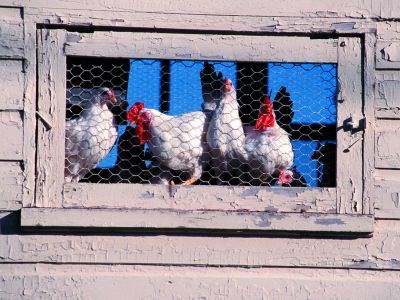The chickens could be coming home to roost if the city moves ahead with an official policy to encourage local food production.
Senior planner Kris Longston told members of the planning committee March 4 that allowing residents to raise chickens in their backyards is one of the ideas some Canadian municipalities are considering to boost local food production.
Other ideas to encourage urban farming include promoting greenhouses and allowing unused city land to be taken over for community gardens.
His address to the committee, however, was for information only, so neighbourhood chicken coops are still far from reality. Longston’s address was to update councillors on ways the city’s Official Plan could be amended to encourage more people to grow or raise their own food.
“Traditionally, we think of food in terms of a farming operations or the grocery store,” he said. “But what it is, really, is a system.”
He said the production, processing, selling, eating and disposal of food is a system that has a huge impact on the local economy. Residents spend about $270 million a year buying food in Greater Sudbury, including $57 million spent in restaurants.
The food system is fragile, he said, especially in light of climate change and soaring fuel and transportation costs. Encouraging more food production locally makes sense on several levels, he said.
“So it’s important to look at how much food you produce locally and what are some ways to augment the systems that are already in place,” Longston said.
A local food production workshop was held in November, which included about 40 people involved in one way or another in Sudbury’s food system. They were asked to look for ways the Official Plan could be amended to boost local food production.
The current Official Plan focuses primarily on farming areas set aside for agricultural reserves.
“It really focuses on just one component of the local food system,” he said. “It doesn’t get into urban food production or the new directions we could possibly see us going in the future …. And what we’re thinking of doing is focusing a lot more on urban food production – community gardens, greenhouses and possibly looking at backyard chickens.”
Creating a community food action plan is one way of plotting out a strategy to increase local food production, as several cities in Canada have already done.
“It’s an assessment of what your local food situation is – production all the way to disposal – and identifying where the gaps are and where they can be improved,” he said. “There is a lot of grassroots support and groups for improving local food production.”
Peggy Baillie, co-chair of the Sudbury Food Policy Council, said the city has a long way to go if the goal is food self-sufficiency.
“I don’t think we’re producing even 10 per cent of what the city’s food needs are,” Baillie said. “We could (become self-sufficient). It’s possible. It would require a lot of work, but we’re not even close right now.”
Ward 3 Coun. Evelyn Dutrisac said the province should provide financial incentives to encourage farming in rural and urban areas.
“There should be some funding opportunities from the province,” Dutrisac said. “I really think if we had more incentives for people to have greenhouses in our city, that would encourage people to build a greenhouse and to cultivate.”
“I haven’t had an opportunity to explore that very far,” Longston replied.” If we were to embark on a local food action plan, that’s something we would flesh out.”
And Ward 6 Coun. Andre Rivest was more than a little concerned about the public reaction to backyard chicken coops.
“Are you suggesting allowing livestock in (residential) areas?” Rivest said. “I could see a lot of public resistance to it.”
Longston said urban chicken coops are not on the horizon anytime soon, since the city’s animal control bylaw would have to be changed to allow it.
“But a number of municipalities are looking at whether it’s feasible to allow chickens – not any livestock larger than that, but chicken coops – in residential neighbourhoods,” he said.
“Whether we go through with that or not, is something that will have to be determined.”
Join Sudbury.com+
- Messages
- Post a Listing
- Your Listings
- Your Profile
- Your Subscriptions
- Your Likes
- Your Business
- Support Local News
- Payment History
Sudbury.com+ members
Already a +member?
Not a +member?
Sign up for a Sudbury.com+ account for instant access to upcoming contests, local offers, auctions and so much more.
